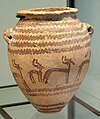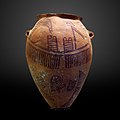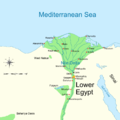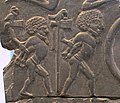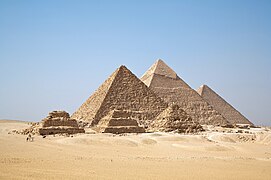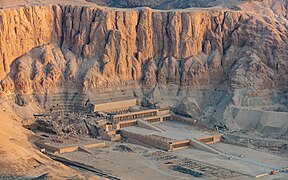|
THE ANCIENT EGYPT PORTAL
Showcased content about Ancient Egypt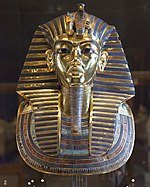 Ancient Egypt was a civilization of ancient Northeast Africa. It was concentrated along the lower reaches of the Nile River, situated in the place that is now the country Egypt. Ancient Egyptian civilization followed prehistoric Egypt and coalesced around 3100 BC (according to conventional Egyptian chronology) with the political unification of Upper and Lower Egypt under Menes (often identified with Narmer). The history of ancient Egypt unfolded as a series of stable kingdoms interspersed by periods of relative instability known as “Intermediate Periods.” The various kingdoms fall into one of three categories: the Old Kingdom of the Early Bronze Age, the Middle Kingdom of the Middle Bronze Age, or the New Kingdom of the Late Bronze Age. Ancient Egypt reached the pinnacle of its power during the New Kingdom, ruling much of Nubia and a sizable portion of the Levant. After this period, it entered an era of slow decline. During the course of its history, Ancient Egypt was invaded or conquered by a number of foreign powers, including the Hyksos, the Nubians, the Assyrians, the Achaemenid Persians, and the Macedonians under Alexander the Great. The Greek Ptolemaic Kingdom, formed in the aftermath of Alexander's death, ruled until 30 BC, when, under Cleopatra, it fell to the Roman Empire and became a Roman province. Egypt remained under Roman control until the 640s AD, when it was conquered by the Rashidun Caliphate. The success of ancient Egyptian civilization came partly from its ability to adapt to the conditions of the Nile River valley for agriculture. The predictable flooding and controlled irrigation of the fertile valley produced surplus crops, which supported a more dense population, and social development and culture. With resources to spare, the administration sponsored mineral exploitation of the valley and surrounding desert regions, the early development of an independent writing system, the organization of collective construction and agricultural projects, trade with surrounding regions, and a military intended to assert Egyptian dominance. Motivating and organizing these activities was a bureaucracy of elite scribes, religious leaders, and administrators under the control of a pharaoh, who ensured the cooperation and unity of the Egyptian people in the context of an elaborate system of religious beliefs.[1] The many achievements of the ancient Egyptians include the quarrying, surveying, and construction techniques that supported the building of monumental pyramids, temples, and obelisks; a system of mathematics, a practical and effective system of medicine, irrigation systems, and agricultural production techniques, the first known planked boats, Egyptian faience and glass technology, new forms of literature, and the earliest known peace treaty, made with the Hittites. Ancient Egypt has left a lasting legacy. Its art and architecture were widely copied, and its antiquities were carried off to far corners of the world. Its monumental ruins have inspired the imaginations of travelers and writers for millennia. A newfound respect for antiquities and excavations in the early modern period by Europeans and Egyptians has led to the scientific investigation of Egyptian civilization and a greater appreciation of its cultural legacy. (Full article...) Selected article - Ancient Egypt was an ancient civilization of eastern North Africa, concentrated along the northern reaches of the Nile River in Egypt. The civilization coalesced around 3150 BC with the political unification of Upper and Lower Egypt under the first pharaoh, and it developed over the next three millennia. Its history occurred in a series of stable kingdoms, separated by periods of relative instability known as intermediate periods. Ancient Egypt reached its pinnacle during the New Kingdom, after which it entered a period of slow decline. Egypt was conquered by a succession of foreign powers in the late period, and the rule of the pharaohs officially ended in 31 BC, when the early Roman Empire conquered Egypt and made it a province. Although the Egyptian military forces in the Old and Middle kingdoms were well maintained, the new form that emerged in the New Kingdom showed the state becoming more organized to serve its needs. For most parts of its long history, ancient Egypt was unified under one government. The main military concern for the nation was to keep enemies out. The arid plains and deserts surrounding Egypt were inhabited by nomadic tribes who occasionally tried to raid or settle in the fertile Nile River valley. Nevertheless, the great expanses of the desert formed a barrier that protected the river valley and was almost impossible for massive armies to cross. The Egyptians built fortresses and outposts along the borders east and west of the Nile Delta, in the Eastern Desert, and in Nubia to the south. Small garrisons could prevent minor incursions, but if a large force was detected a message was sent for the main army corps. Most Egyptian cities lacked city walls and other defenses. (Full article...)Selected picture
The Great Sphinx of Giza, partially excavated, with two pyramids in the background. Did you know...
News5th September 2018. Rock-cut Tomb discovered in a 4,000-year-old Elite Cemetery August 2018: in the tomb of the mayor of Memphis Ptahmose who dates around 1300 BC was found well preserved cheese, more than 3000 years old. [1] Selected biography -Ahmose I (sometimes written as Amosis or Aahmes, meaning "Iah (the Moon) is born") was a pharaoh and founder of the Eighteenth Dynasty of Egypt, classified as the first dynasty of the New Kingdom of Egypt, the era in which ancient Egypt achieved the peak of its power. He was a member of the Theban royal house, the son of pharaoh Seqenenre Tao and brother of the last pharaoh of the Seventeenth Dynasty, Kamose. During the reign of his father or grandfather, Thebes rebelled against the Hyksos, the rulers of Lower Egypt. When he was seven years old, his father was killed, and he was about ten when his brother died of unknown causes after reigning only three years. Ahmose I assumed the throne after the death of his brother, and upon coronation became known as Nebpehtyre, nb-pḥtj-rꜥ "The Lord of Strength is Ra". During his reign, Ahmose completed the conquest and expulsion of the Hyksos from the Nile Delta, restored Theban rule over the whole of Egypt and successfully reasserted Egyptian power in its formerly subject territories of Nubia and Canaan. He then reorganized the administration of the country, reopened quarries, mines and trade routes and began massive construction projects of a type that had not been undertaken since the time of the Middle Kingdom. This building program culminated in the construction of the last pyramid built by native Egyptian rulers. Ahmose's reign laid the foundations for the New Kingdom, under which Egyptian power reached its peak. His reign is usually dated to the mid-16th century BC. (Full article...)General imagesThe following are images from various ancient Egypt-related articles on Wikipedia.
Related portalsWikiProjectsMain topics
Notable Pharaohs
CategoriesRecognized contentFeatured articles
Featured listsGood articles
Did you know? articles
Featured pictures
In the News articlesMain page featured articles
Main page featured listsPicture of the day pictures
Things to do
WikimediaThe following Wikimedia Foundation sister projects provide more on this subject:
Sources
Discover Wikipedia using portals |





